Pulse-Height and 2-D Charge-Spread Single-Pixels Studies on a LuYAP:Ce Scintillation Array
Abstract
:1. Introduction
2. Materials and Methods
3. Crystal-Array Characterizations
3.1. Crystal-Pixel’s Pulse-Height Response
- *Qnet(i,k) = Normalized Qnet value of ith event of the kth crystal-pixel;
- Qnet(i,k) = Qnet value of ith event of the kth crystal-pixel;
- Qnet(k) = Average Qnet value of the kth crystal-pixel;
- Nep = No. of events falling in the crystal-pixel;
- Npix = No. of pixels.
3.2. Crystal-Pixel’s 2D Charge-Symmetry Response (FWTM)
3.2.1. Co-57 FWTMxy Scatter-Plots
- (a)
- A photo-electric interaction takes place in the matter if the incident photon annihilates and its energy is transferred to an atomic electron, net of its binding energy. The majority of photo-electric interactions ionize an atom of the scintillator at the top of crystal-pixel, within the first mean-free-path, with a probability of about 0.63. The following scintillation light-spot is transmitted by the residual length of crystal-pixel, acting as light-pipe, toward the light-output face and, finally, to the photo-cathode of PSPMT, via its optical window. The 2-D charge distribution at anodes will be narrow, due to the light-focusing around the pixel-axis carried out by the light-pipe, and symmetric, because the energy of the incident photon has been released completely inside the crystal-pixel. So, the events absorbed at the top of the pixel will fall along the bisector of the plane (FWTMx, FWTMy) and near the origin forming the dense cloud close to the origin.
- (b)
- In addition, the rest of photo-electric interactions take place at a depth ranging from about 1 to 10 mm of crystal-pixel length, with a probability of about 0.37. The photon energy is released by ionizing an atom of the scintillator, and the light-spot will produce a 2-D charge distribution at PSPMT anodes. The focusing effect of the light-guide will be reduced compared to case (a), giving rise to a wider charge distribution whose maximum spread value corresponds to the maximum detectable by the given detector setup. The 2-D charge distribution is again symmetric because the energy of the incident photon has been released completely inside the crystal-pixel. The representative point on the plot is located on the bisector, but farther away from the origin.
- (c)
- The ionization process itself cited in (a) and (b) ends up producing also X-rays, typical of components of scintillator, like the Lu K 63.2 keV (maximum energy value for Lu K sub-shell) whose mean-free-path value in (Lu0.7Y0.3)AP is about 0.7 mm. If the emission of X-ray takes place near to the pixel-surface, and in its direction, the X-ray has a significant probability of escaping from the pixel and being absorbed in a neighboring one. In the time-scale of electronic signals, the “primary” ionization and the one following X-ray absorption are coincident, thus the scintillation spots at the output faces of the primary and the neighboring pixels contribute to the same pulse. Therefore, the charge distribution at PSPMT anodes becomes broader, the amount of broadening depending, in principle, on the energy quantities deposited in the two pixels. For Co-57 data, one may observe that Lu K X-ray energy is about half of 122.1 keV Co-57 emission. This produces a charge distribution at PSPMT anodes having double-width compared to the case of X-ray emission taking place near to the pixel-surface, but toward the pixel-axis. X-ray escape-events are located in the plane (FWTMx, FWTMy) along the trails, parallel to axes, connected to the dense cloud of events close to the origin. An event belongs to a horizontal trail if X-ray escape and primary pixels are in the same row of the crystal-array (c1). On the contrary, the point belongs to the vertical trail (c2). One may finally observe from experimental plots, that the distance between the point and the dense cloud, along the trail, is related to the DoI in primary crystal-pixel. In better detail, the greater the DoI (i.e., the lesser the distance between the point-of-interaction and the light-output-face) the wider the charge-distribution, the maximum value of the distribution width being measured if the interaction takes place in close proximity to the light output face itself.
- (d)
- A scattering process, takes place in the matter if a photon interacts with a free or weakly-bound electron. The primary photon disappears, and a secondary photon appears, having lower energy, and traveling along a different angular direction on the plane including both the trajectories. In order to respect the energy balance, a fraction of primary photon energy, depending on the diffusion angle, is transferred to the recoil-electron that is converted into a scintillation spot. From the standpoint of deposited energy, the story of a primary photon may evolve in a twofold manner. After undergoing one or more scattering processes in the array, the last diffused photon may: (d1) undergo a photo-electric process, or (d2) escape from the crystal-array. Like in case (c), in the scale of electronic signals, cited processes are time-coincident, thus the scintillation spots at the output faces of the involved pixels contribute to the same charge pulse at the PSPMT anodes. Case (d1) is identical to photo-electric process (a) or (b) because the deposited energy is the same, but it may be rejected on the basis of the 2-D charge-distribution asymmetry. On the contrary, the events like (d2) may be refused only if the value of energy deposited in the array is external to the energy window set for events acceptance.
3.2.2. Comments
3.3. Crystal-Pixel’s 2D Charge-Symmetry Response (Fsym)
- Thr1,2 (pix) correspond, respectively, to the minus or plus sign in the second term of Equation (6) for a given crystal-pixel. The thresholds define the windows of acceptance of single-events by a given degree of symmetry of 2-D charge-distributions for the given pixel;
- Fsym* represents the average of the Fsym(n) values characterizing the single-events belonging to the given crystal-pixel;
- κ is a real number to be used for events clustering. It represents a multiplier factor defining the width of the acceptance window, and
- σ(Fsym*) is the standard deviation of Fsym*.
3.3.1. Fsym Distributions from Co-57, Ba-133, Cs-133, and Lu-176
3.3.2. Comments
3.4. Ten-Pixels Subsets Selection
4. Conclusions
Author Contributions
Funding
Data Availability Statement
Conflicts of Interest
Appendix A. Additional Experimental Materials
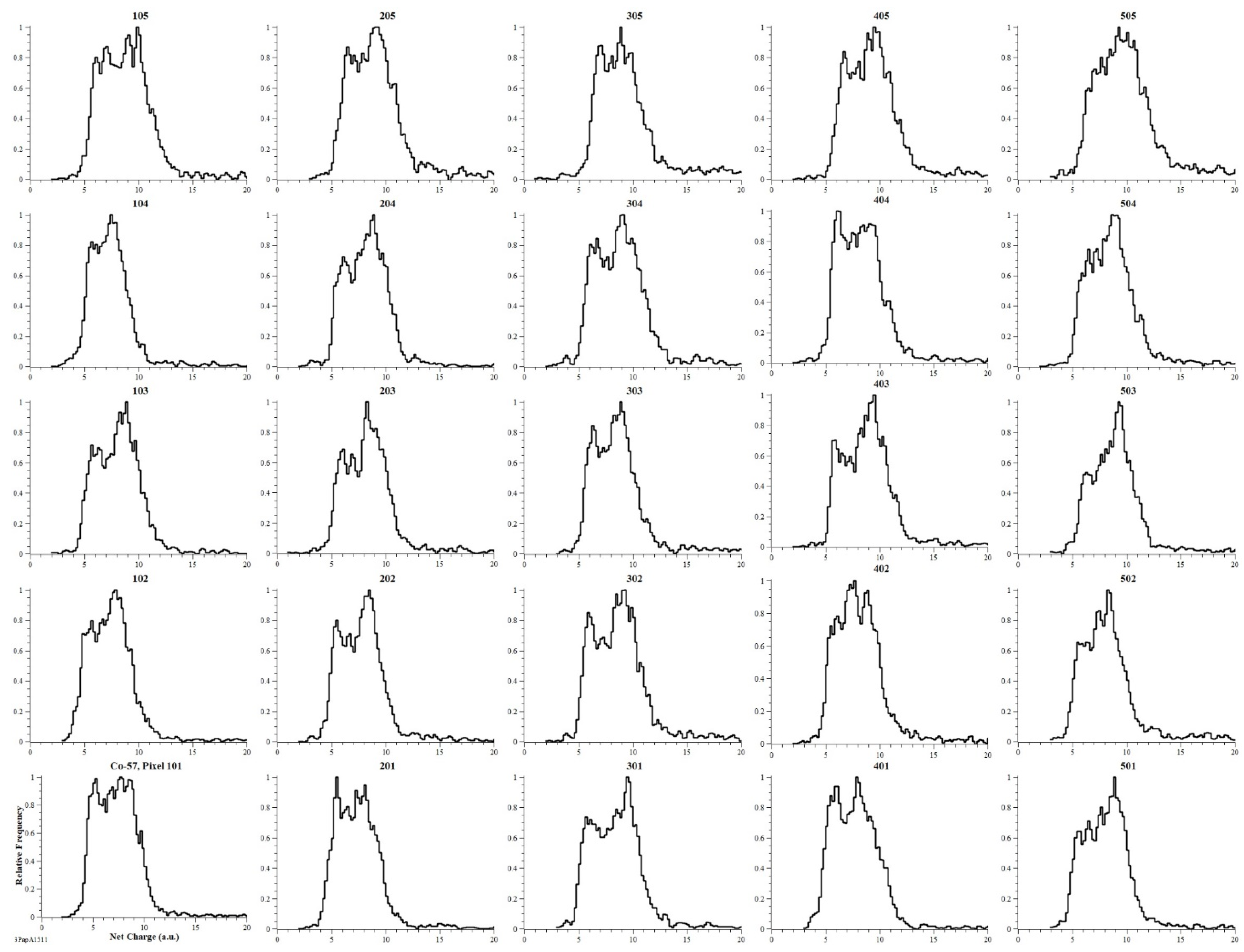
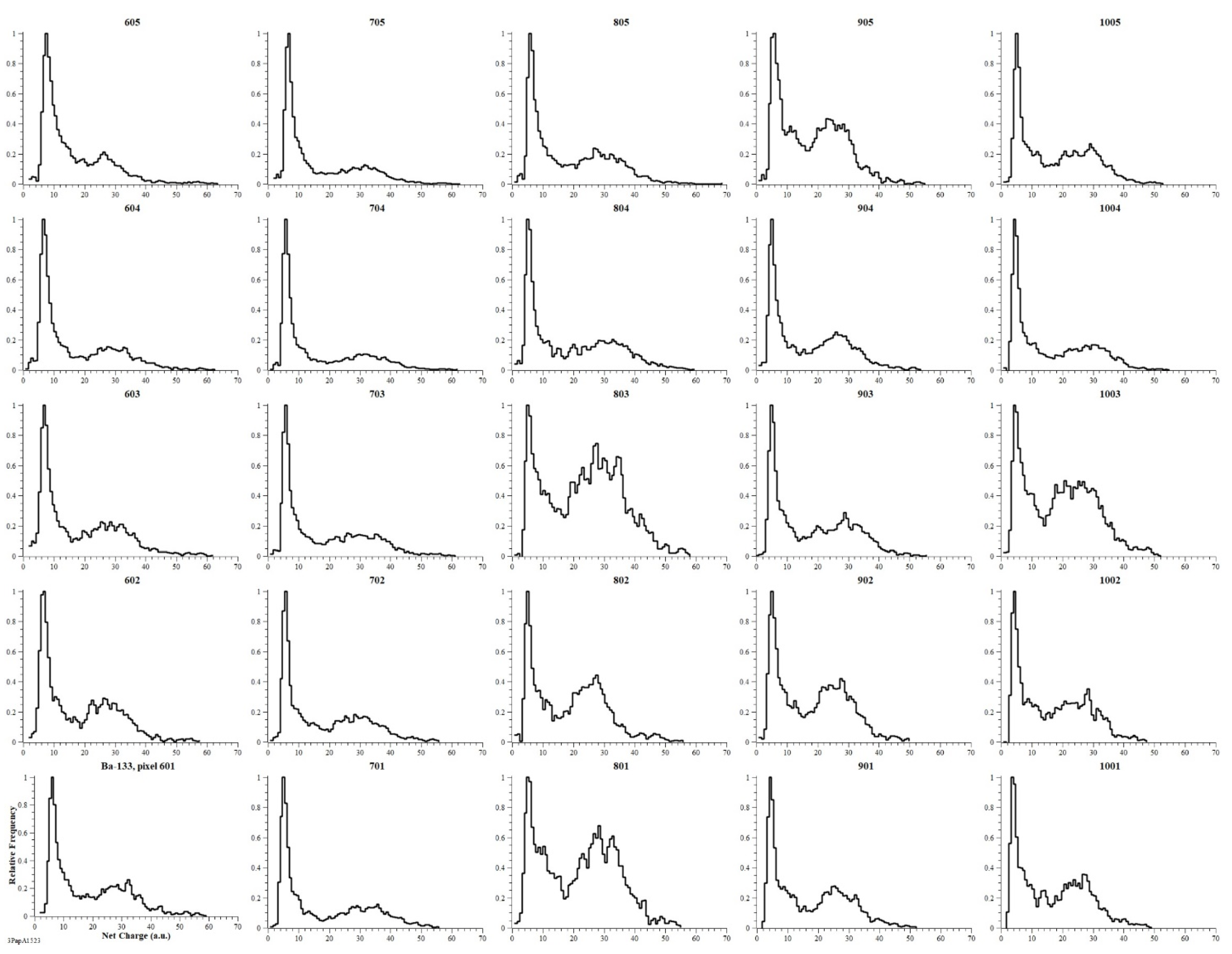
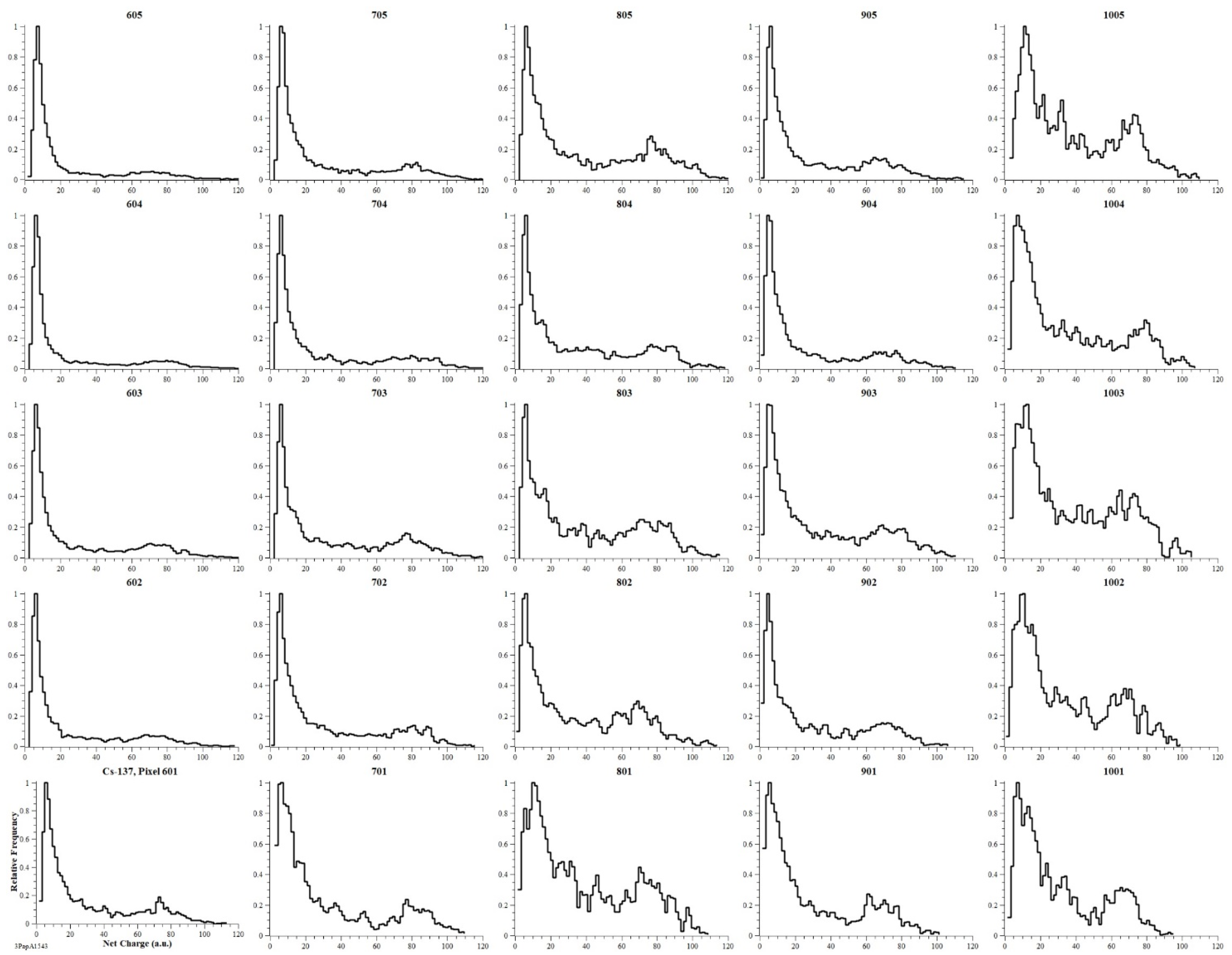
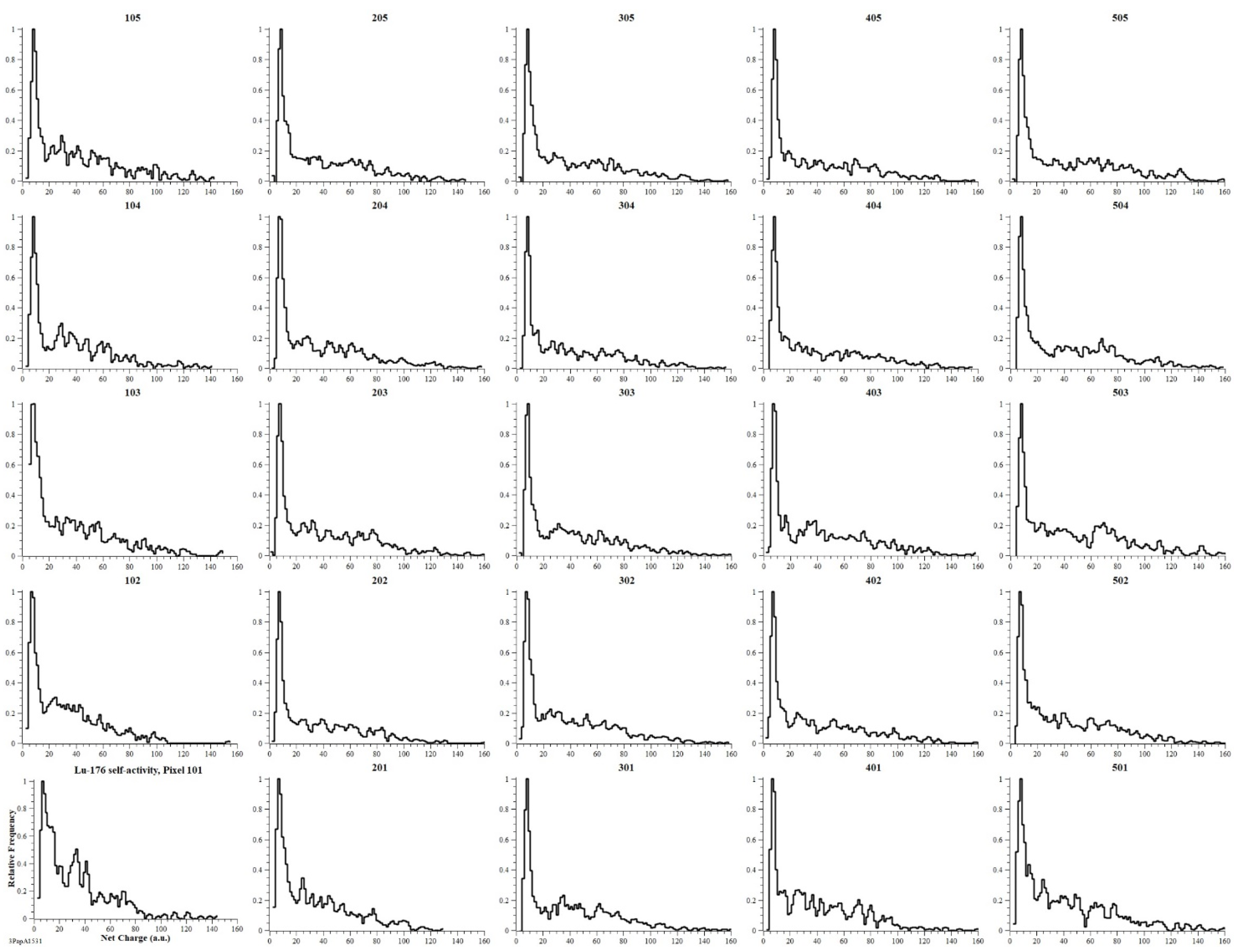
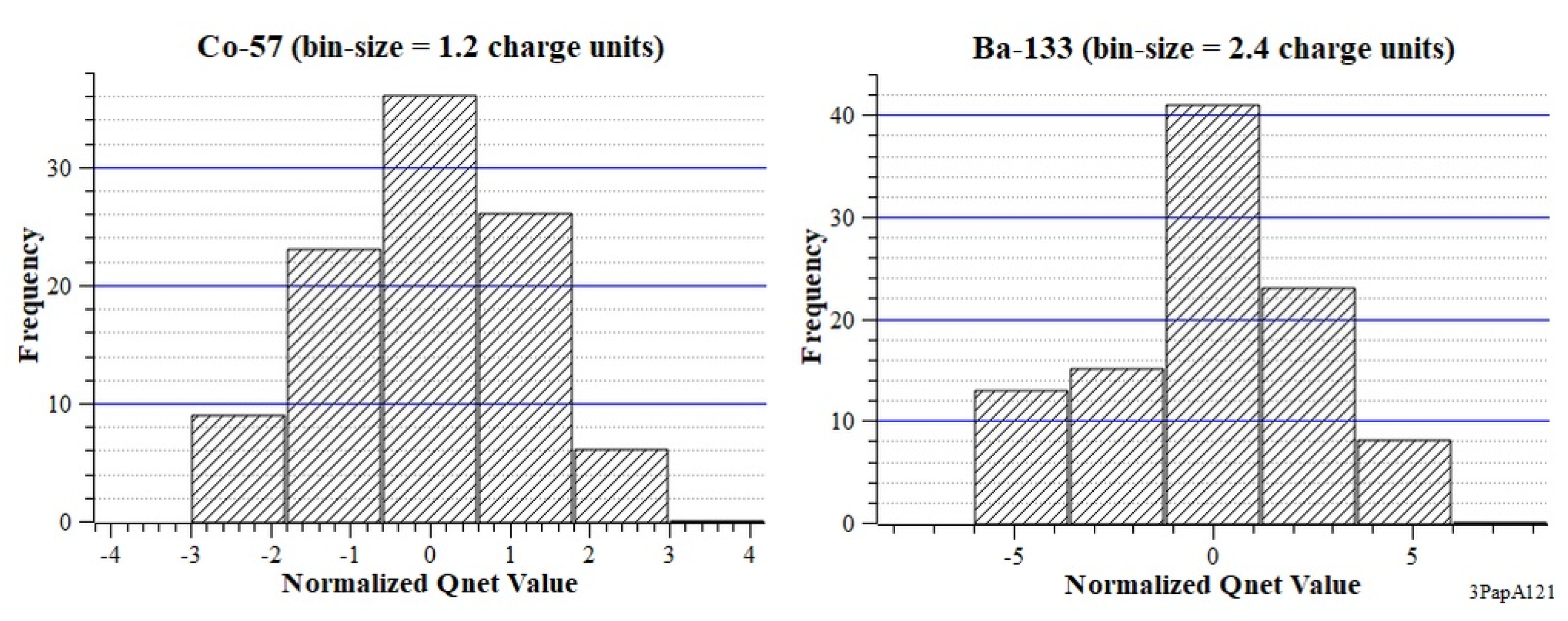
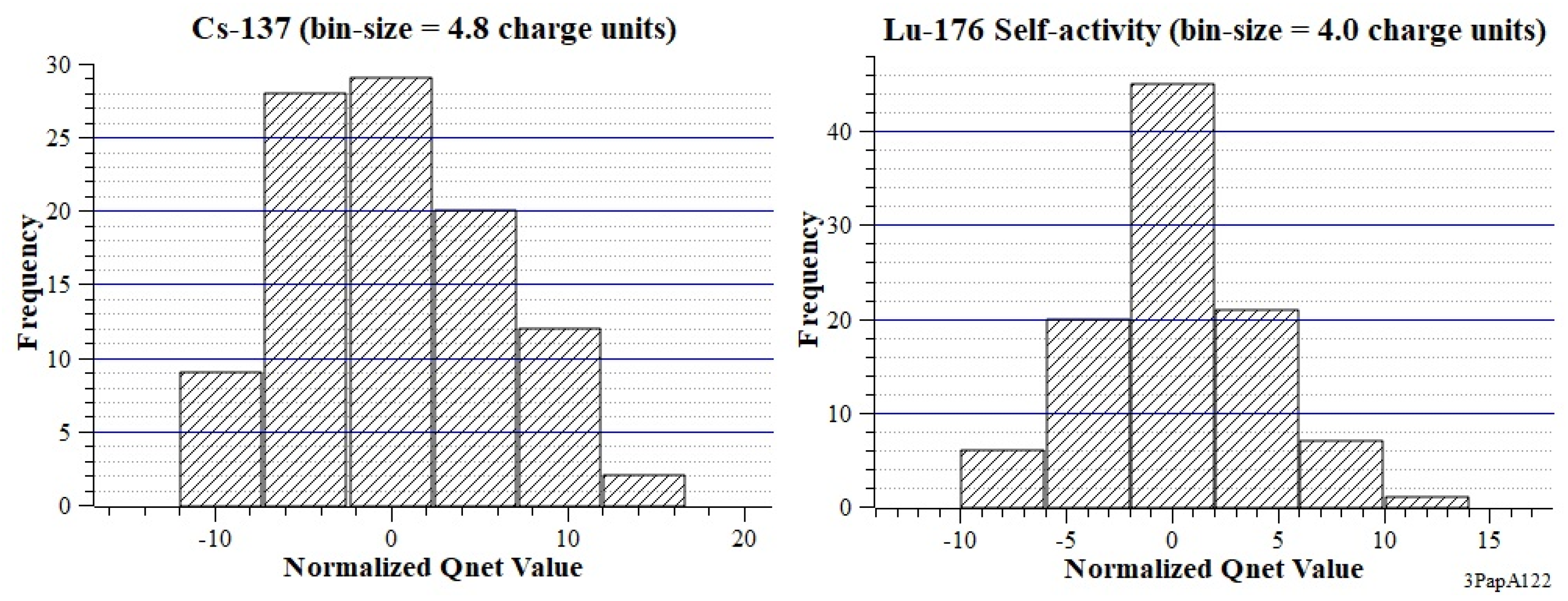

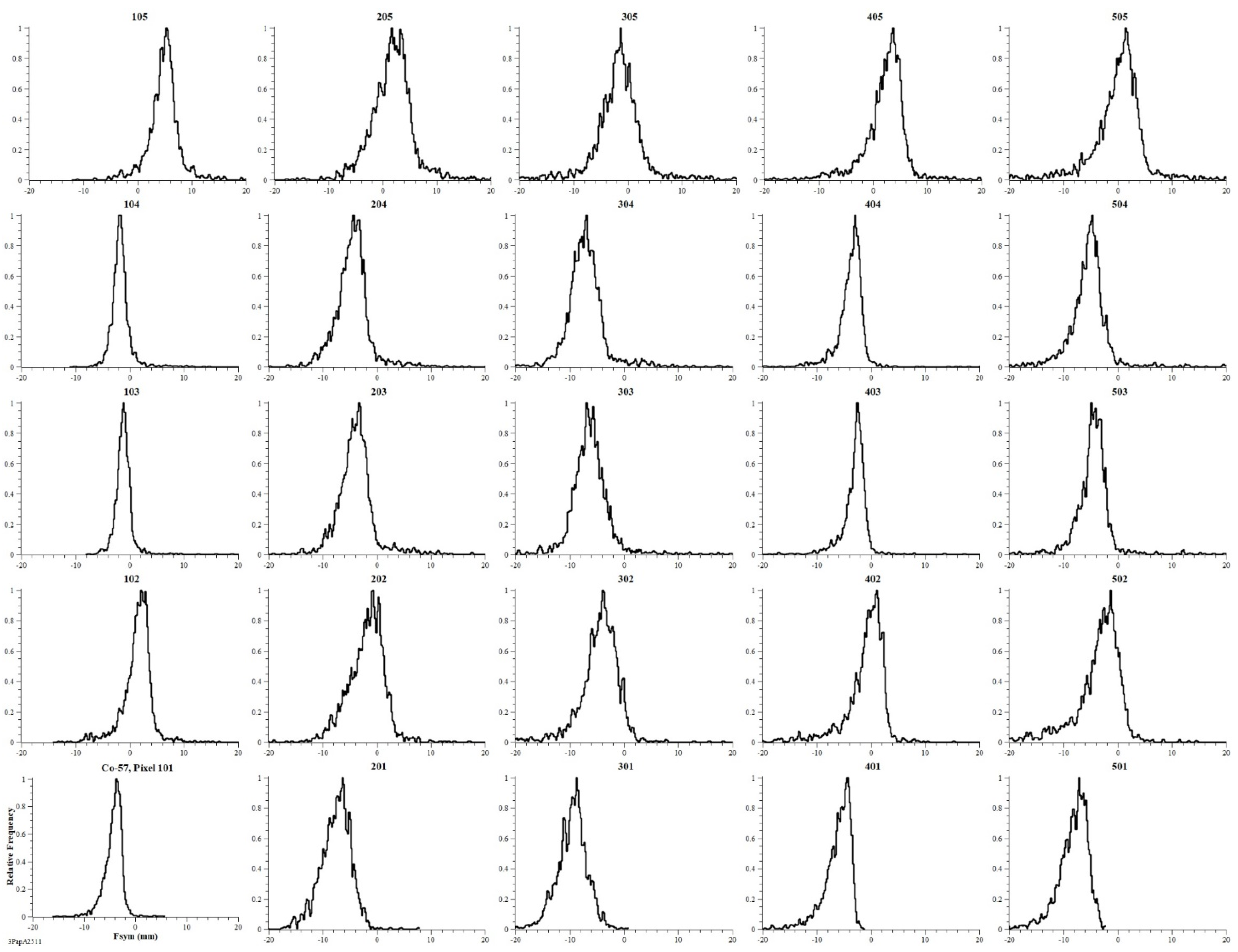
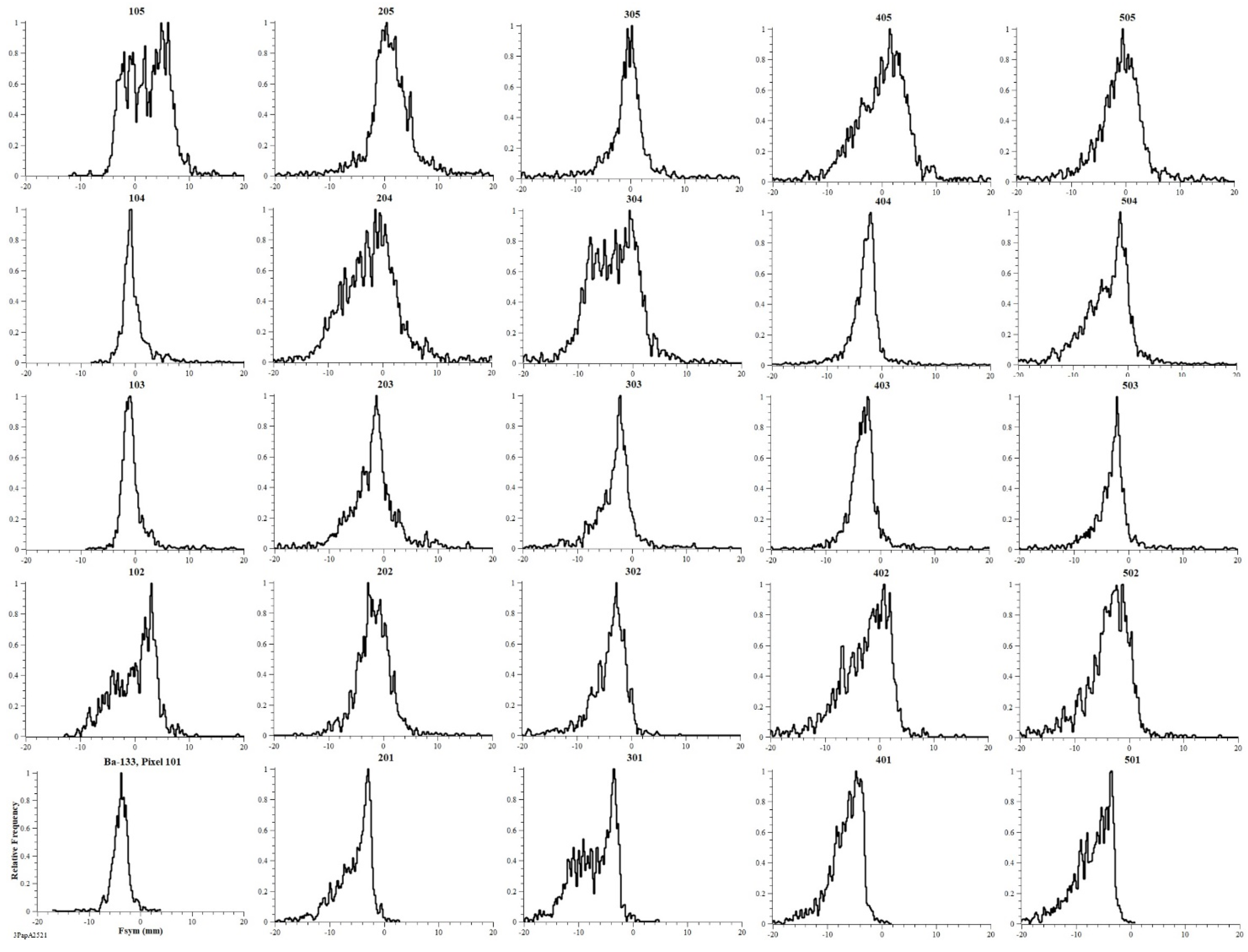
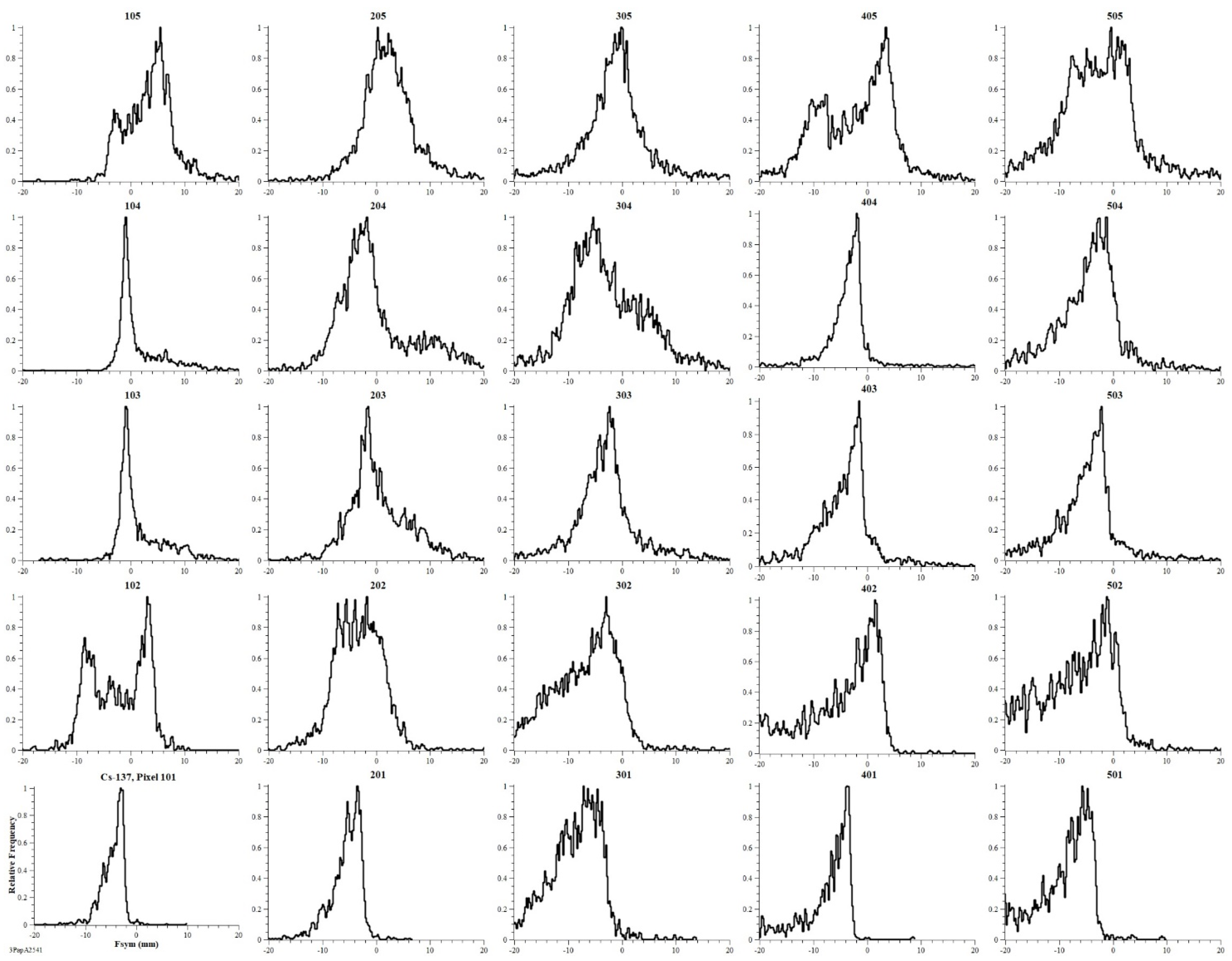

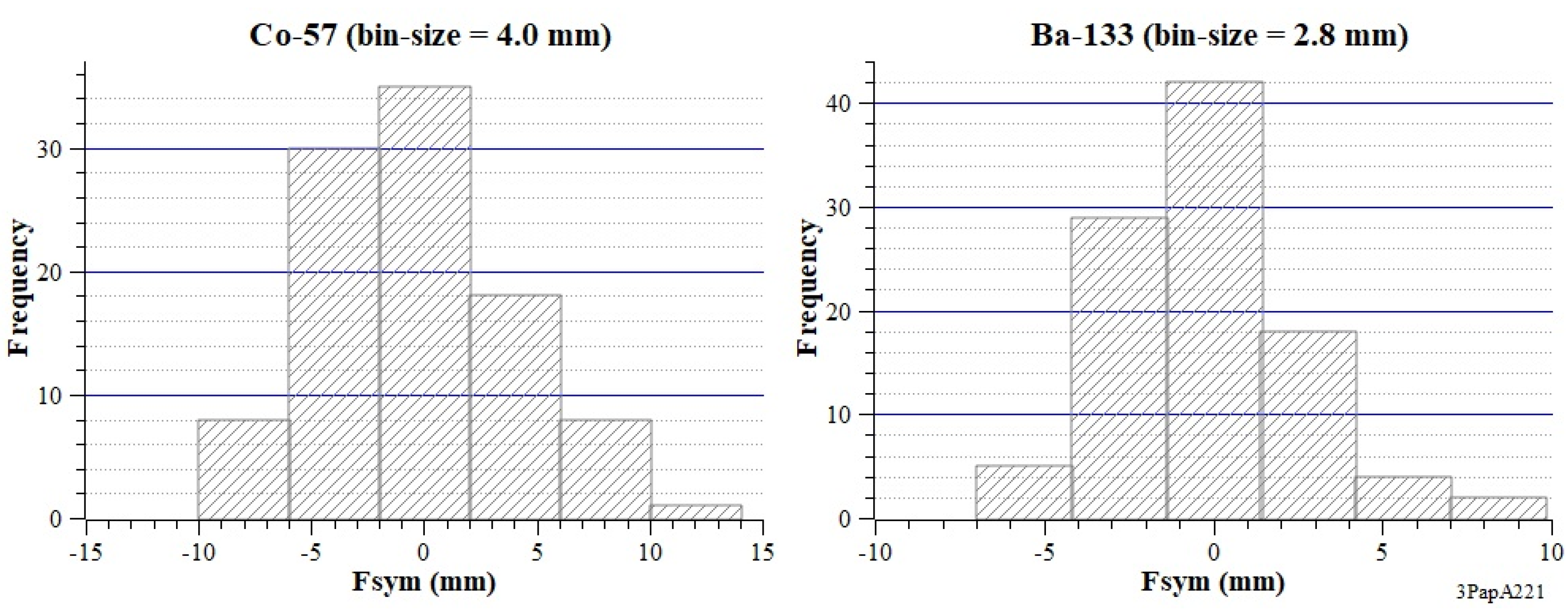
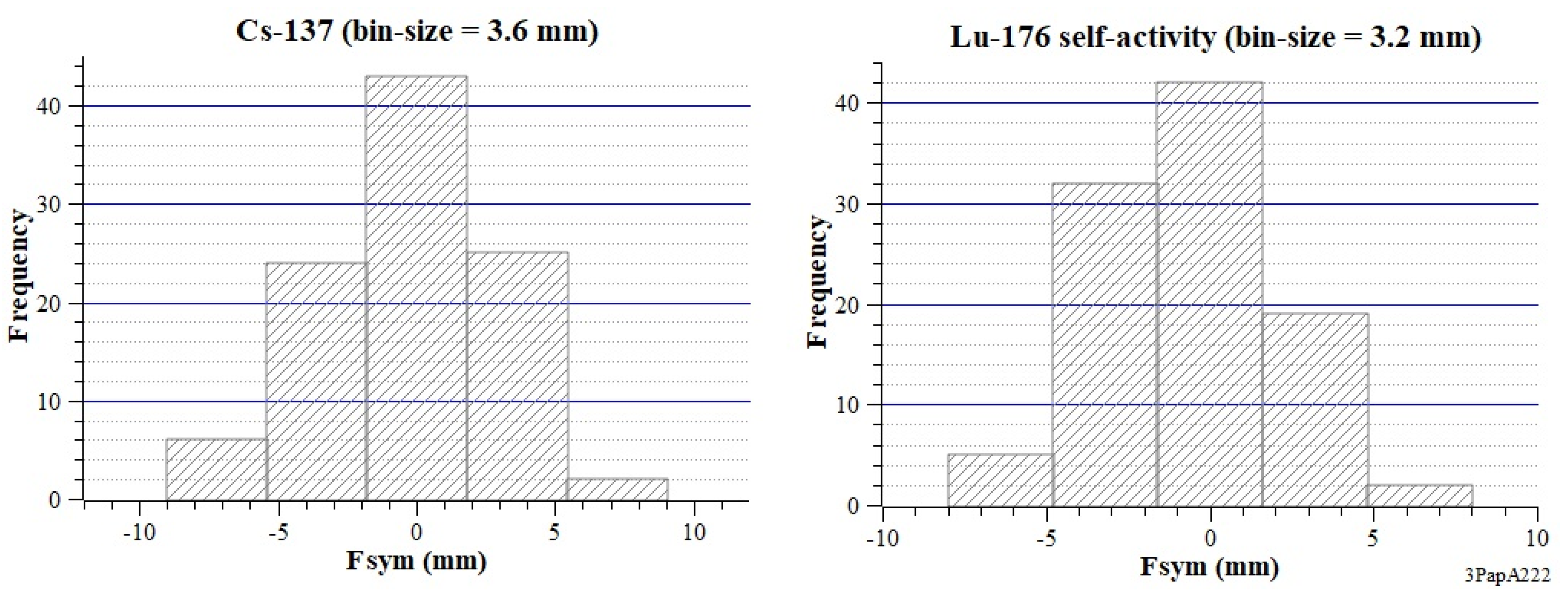






References
- Pani, R.; de Notaristefani, F.; Blazek, K.; Maly, P.; Pellegrini, R.; Pergola, A.; Soluri, A.; Scopinaro, F. Multi-Crystal YAP:Ce Detector System for Position Sensitive Measurements, 3rd ed.; London Conference on Position-Sensitive Detectors, PSD-3: Uxbridge, UK, 1993; also published in Nucl. Instrum. Methods Phys. Res. Sect. A 1994, 348, 551–558. [Google Scholar]
- Casey, M.E.; Nutt, R. A multicrystal two dimensional BGO detector system for positron emission tomography. IEEE Trans. Nucl. Sci. 1986, 33, 460–463. [Google Scholar] [CrossRef]
- Levin, C.S.; Hoffman, E.J. Calculation of positron range and its effect on the fundamental limit of positron emission tomography system spatial resolution. Phys. Med. Biol. 1999, 44, 781–799. [Google Scholar] [CrossRef] [PubMed]
- Shibuya, K.; Yoshida, E.; Nishikido, F.; Suzuki, T.; Tsuda, T.; Inadama, N.; Yamaya, T.; Murayama, H. Annihilation photon acollinearity in PET: Volunteer and phantom FDG studies. Phys. Med. Biol. 2007, 52, 5249–5262. [Google Scholar] [CrossRef] [PubMed]
- Shao, Y.; Cherry, S.; Siegel, S.; Silverman, R. A study of inter-crystal scatter in small scintillator arrays designed for high resolution PET imaging. IEEE Trans. Nucl. Sci. 1996, 43, 1938–1944. [Google Scholar] [CrossRef]
- Park, S.; Rogers, W.; Clinthorne, N. Effect of Intercrystal Compton Scatter on Efficiency and Image Noise in Small Animal PET Module. In Proceedings of the IEEE Nuclear Science Symposium Conference Record, Portland, OR, USA, 19–25 October 2003; pp. 2272–2277. [Google Scholar]
- Anger, H.O. Scintillation Camera. Rev Sci Instrum. 1953, 29, 27–33. [Google Scholar] [CrossRef]
- Pani, R.; Cinti, M.N.; Scafè, R.; Bennati, P.; Meo, S.L.; Preziosi, E.; Pellegrini, R.; de Vincentis, G.; Sacco, D.; Fabbri, A. A study of response of a LuYAP:Ce array with innovative assembling for PET. Nucl. Instrum. Methods Phys. Res. Sect. A 2015, 795, 82–87. [Google Scholar] [CrossRef]
- Scafè, R.; Pellegrini, R.; Cinti, M.N.; Puccini, M.; Pani, R. A novel scintillation imager with charge-spread discrimination. Analytical models suitable for crystal-arrays. Nucl. Instrum. Methods Phys. Res. Sect. A 2016, 833, 110–121. [Google Scholar] [CrossRef]
- Scafè, R.; Pellegrini, R.; Puccini, M.; Cinti, M.N. Pani Rejection of events undergoing multiple interactions within a scintillation crystal array based on spatial charge spread discrimination for gamma-ray imaging. Nucl. Instrum. Methods Phys. Res. Sect. A 2017, 870, 97–102. [Google Scholar] [CrossRef]
- Savitzky, A.; Golay, M.J.E. Smoothing and Differentiation of Data by Simplified Least Squares Procedures. Anal. Chem. 1964, 36–38, 1627–1638. [Google Scholar] [CrossRef]
- Knoll, G.F. Radiation Detection and Measurement, 3rd ed.; John Wiley & Sons: New Hoboken, NJ, USA, 2000; pp. 247–250. [Google Scholar]


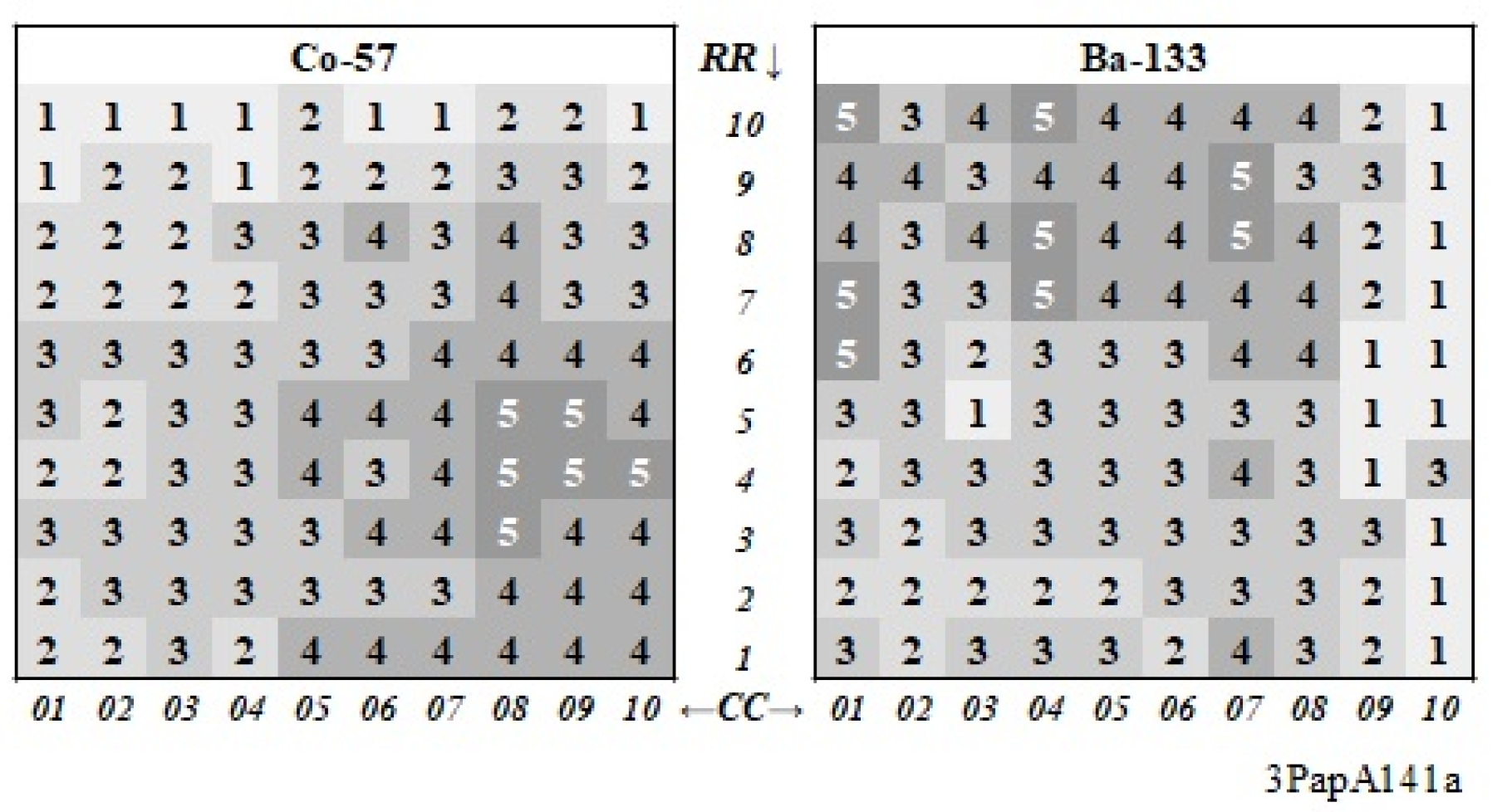
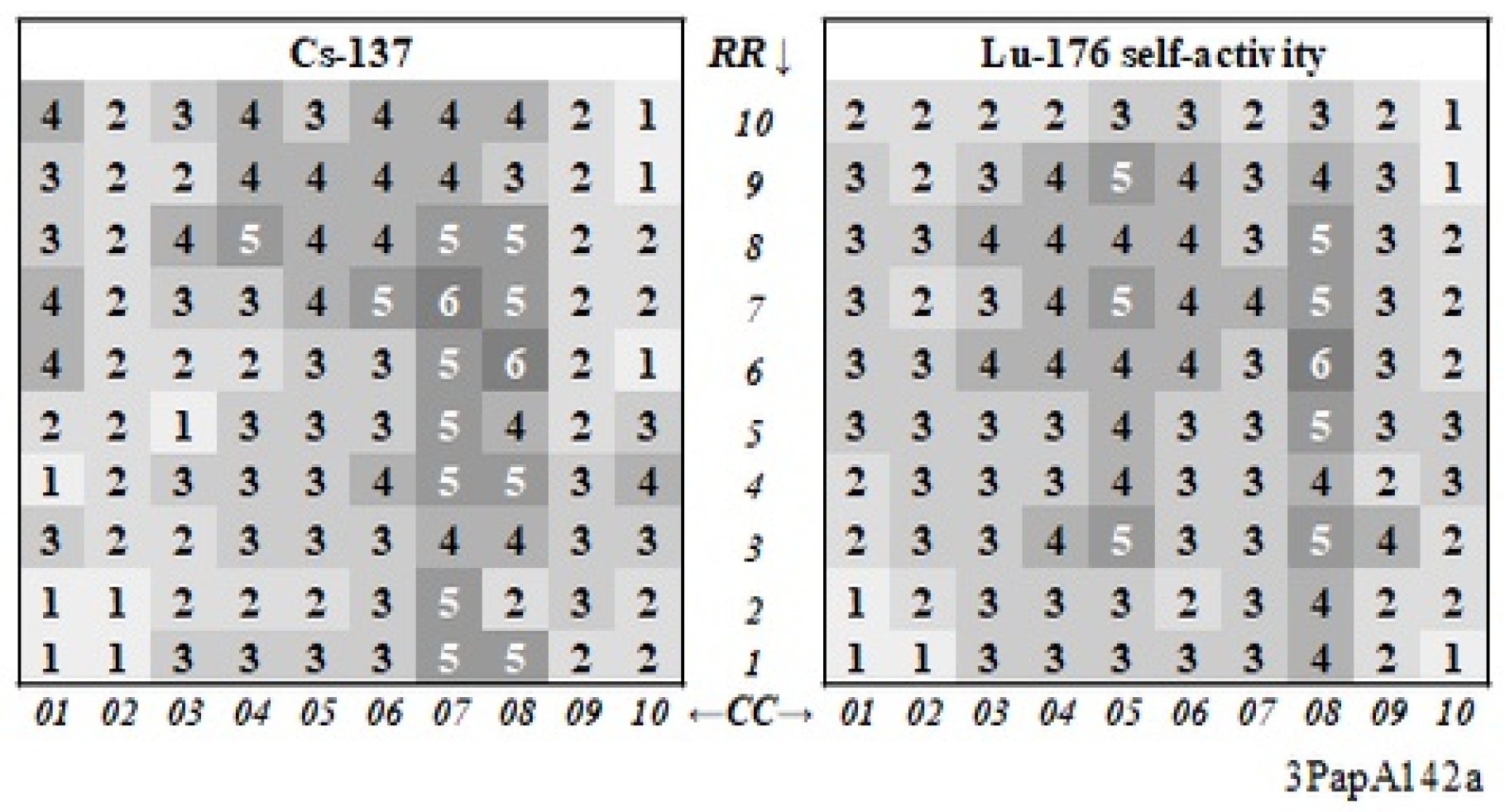
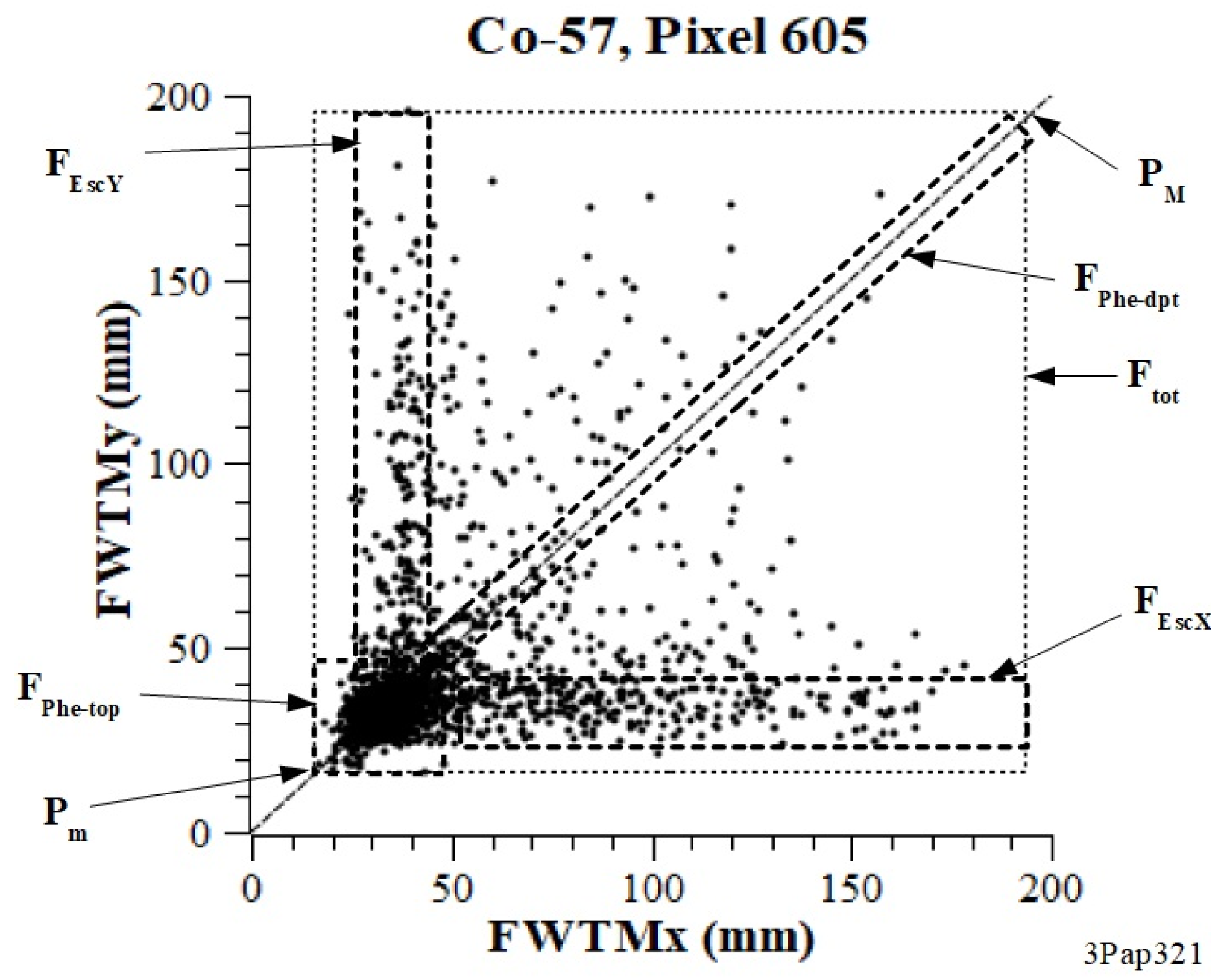


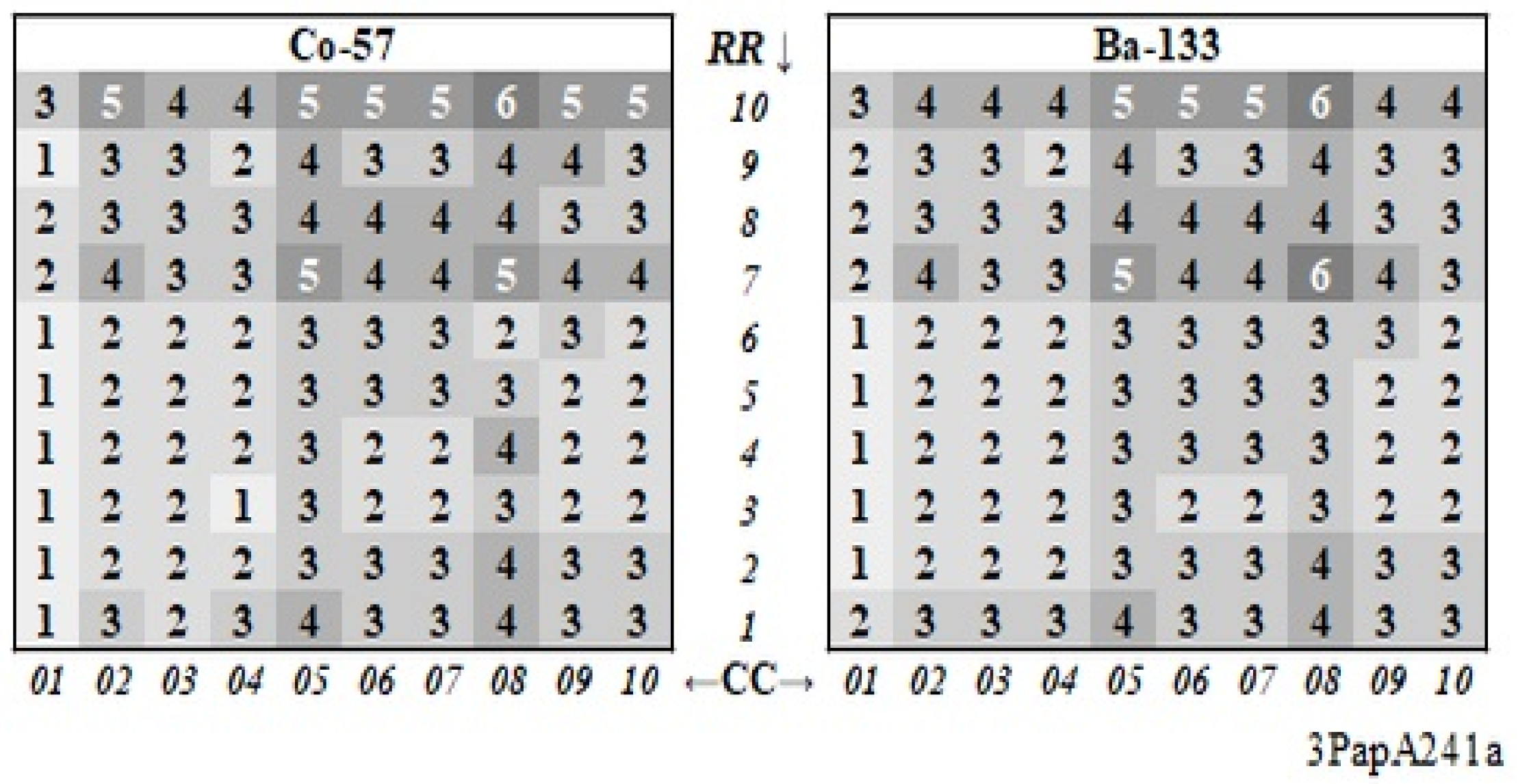
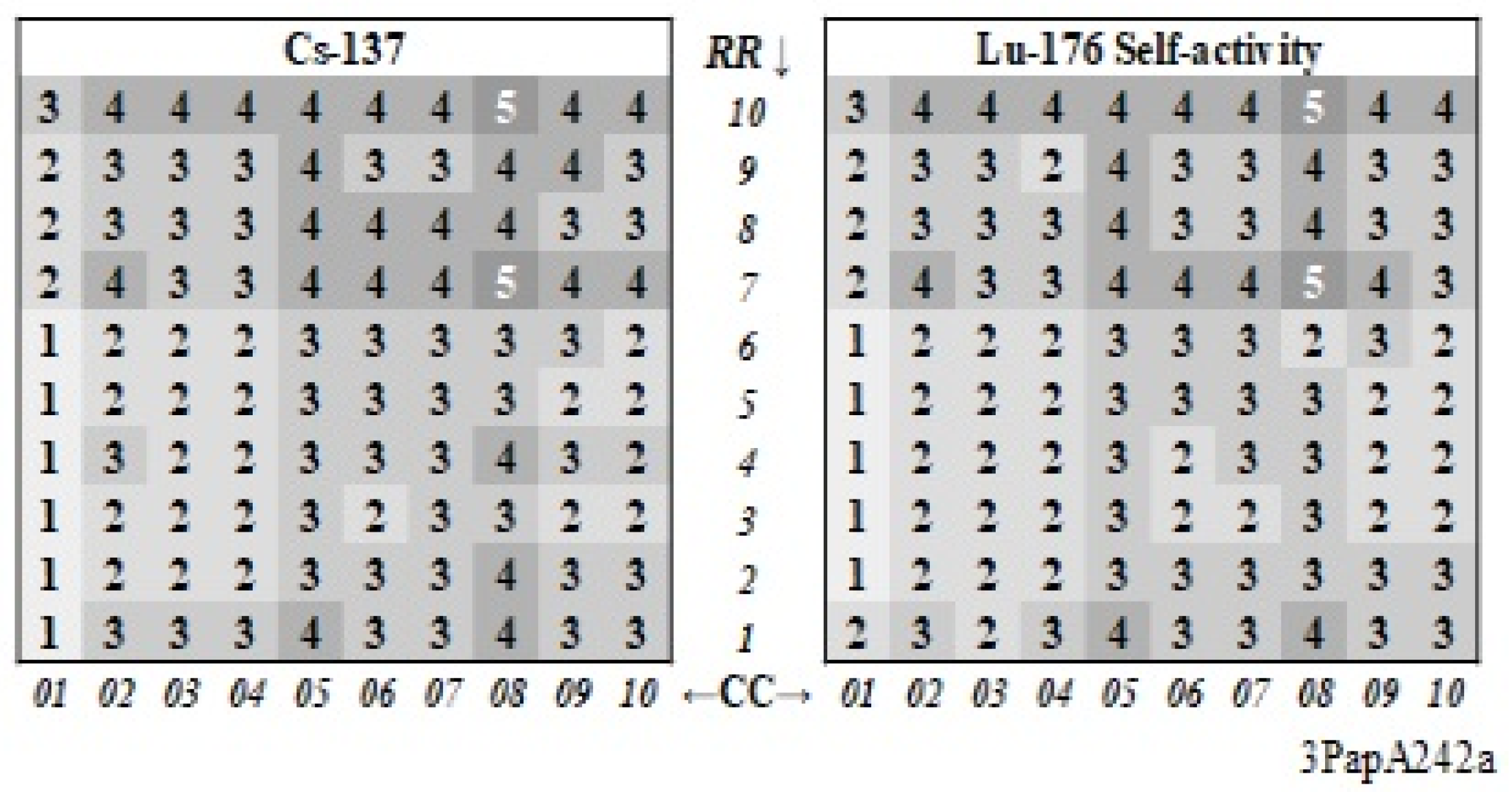






| Parameter | Co-57 | Ba-133 | Lu-176 Self-Activity | Cs-137 |
|---|---|---|---|---|
| Centroid of … | ||||
| 122- to 136-keV Peaks | 276- to 384-keV Peaks | All Spectrum | 662-keV Peak | |
| Average (ch.u.) | 8.8 | 29.5 | 38.6 | 71.6 |
| St. Dev. (ch.u.) | 1.2 | 2.5 | 3.8 | 5.8 |
| Minimum (ch.u.) | 5.8 | 23.9 | 29.2 | 60.2 |
| Maximum (ch.u.) | 11.1 | 34.7 | 49.9 | 85.6 |
| (Max-Min)/Average | 0.60 | 0.37 | 0.53 | 0.35 |
| Domain | No. of Events | Relative Frequency |
|---|---|---|
| Ftot | 2962 | 1.000 |
| FPhe-Top | 2162 | 0.730 |
| FEscX | 306 | 0.103 |
| FEscY | 173 | 0.058 |
| FPhe-Dpt | 153 | 0.052 |
| FScatt | 168 | 0.057 |
| Parameter | Co-57 | Ba-133 | Lu-176 Self-Activity | Cs-137 |
|---|---|---|---|---|
| Average (mm) | −0.4 | −0.3 | −0.6 | −0.5 |
| St. Dev. (mm) | 4.3 | 2.7 | 2.8 | 3.1 |
| Minimum (mm) | −9.6 | −6.7 | −7.1 | −8.1 |
| Maximum (mm) | 12.6 | 8.1 | 6.8 | 6.9 |
| (Max-Min)/Aver. | −56 | −45 | −24 | −32 |
| The 10 pixels of the 10 × 10 Array Having the … | |||||||
|---|---|---|---|---|---|---|---|
| … Most Similar Net-Charge Values | … Best Charge-Spread Symmetry Values | ||||||
| Co-57 | Ba-133 | Cs-137 | Lu-176 self-act. | Co-57 | Ba-133 | Cs-137 | Lu-176 self-act. |
| 206 | 105 | 104 | 108 | 107 | 107 | 103 | 107 |
| 207 | 204 | 301 | 303 | 110 | 110 | 104 | 110 |
| 301 | 206 | 305 | 305 | 402 | 209 | 107 | 209 |
| 304 | 309 | 403 | 309 | 406 | 305 | 110 | 210 |
| 403 | 405 | 405 | 502 | 409 | 609 | 704 | 704 |
| 406 | 501 | 504 | 701 | 703 | 704 | 710 | 710 |
| 604 | 503 | 505 | 702 | 704 | 803 | 803 | 803 |
| 709 | 606 | 506 | 706 | 803 | 810 | 810 | 810 |
| 710 | 608 | 510 | 810 | 804 | 902 | 902 | 902 |
| 809 | 801 | 901 | 905 | 1001 | 1001 | 1001 | 1001 |
Publisher’s Note: MDPI stays neutral with regard to jurisdictional claims in published maps and institutional affiliations. |
© 2021 by the authors. Licensee MDPI, Basel, Switzerland. This article is an open access article distributed under the terms and conditions of the Creative Commons Attribution (CC BY) license (https://creativecommons.org/licenses/by/4.0/).
Share and Cite
Scafè, R.; Puccini, M.; Pellegrini, R.; Pani, R. Pulse-Height and 2-D Charge-Spread Single-Pixels Studies on a LuYAP:Ce Scintillation Array. Instruments 2021, 5, 26. https://doi.org/10.3390/instruments5030026
Scafè R, Puccini M, Pellegrini R, Pani R. Pulse-Height and 2-D Charge-Spread Single-Pixels Studies on a LuYAP:Ce Scintillation Array. Instruments. 2021; 5(3):26. https://doi.org/10.3390/instruments5030026
Chicago/Turabian StyleScafè, Raffaele, Marco Puccini, Rosanna Pellegrini, and Roberto Pani. 2021. "Pulse-Height and 2-D Charge-Spread Single-Pixels Studies on a LuYAP:Ce Scintillation Array" Instruments 5, no. 3: 26. https://doi.org/10.3390/instruments5030026
APA StyleScafè, R., Puccini, M., Pellegrini, R., & Pani, R. (2021). Pulse-Height and 2-D Charge-Spread Single-Pixels Studies on a LuYAP:Ce Scintillation Array. Instruments, 5(3), 26. https://doi.org/10.3390/instruments5030026







